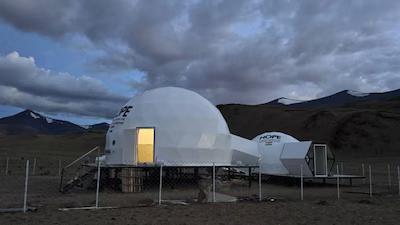
ISRO sets up station in Ladakh to simulate life on Moon & Mars
In a groundbreaking initiative, the Indian Space Research Organisation (ISRO) has established a unique station in Ladakh’s Tso Kar Valley, aptly named the Himalayan Outpost for Planetary Exploration (HOPE). The facility has been set up to simulate life on the Moon and Mars, and it’s a significant step towards India’s ambitious plans to explore the Martian terrain.
The HOPE station is designed to test life-support systems for future lunar and Martian missions. Two crew members will undertake various tests at the facility from August 1 to 10, simulating life on the harsh Martian environment. The valley was chosen for its remarkable similarity to Mars, with high UV radiation, low atmospheric pressure, extreme cold, and saline permafrost.
Located at an altitude of 15,000 feet, Tso Kar Valley is one of the most remote and inhospitable regions in Ladakh. The extreme conditions in the valley provide an ideal setting to test the endurance of life-support systems, which will be crucial for future space missions.
The HOPE station is equipped with state-of-the-art equipment and infrastructure, including a habitat, life-support systems, and communication networks. The crew members will conduct a range of experiments, including testing the effectiveness of water recycling systems, air purification, and waste management.
The Indian Space Research Organisation has been working towards establishing a human settlement on the Moon and Mars in the near future. The HOPE station is a crucial step towards achieving this goal. By simulating life on Mars, ISRO can identify and overcome the challenges that astronauts might face during a real Martian mission.
According to ISRO, the HOPE station will help scientists and engineers to:
- Test life-support systems: The station will evaluate the effectiveness of life-support systems, including air, water, and food production, waste management, and communication networks.
- Develop strategies for Martian exploration: The crew members will conduct experiments to develop strategies for coping with the harsh Martian environment, including extreme temperatures, low air pressure, and high UV radiation.
- Train astronauts for Martian missions: The HOPE station will provide a unique opportunity for astronauts to train in a Martian-like environment, preparing them for the challenges they may face during a real Martian mission.
The HOPE station is a testament to India’s growing capabilities in space exploration and its determination to become a major player in the global space industry. With this initiative, ISRO is taking a significant step towards establishing India’s presence on the Moon and Mars.
As Dr. K Sivan, Chairman, ISRO, said, “The HOPE station is a pioneering effort to simulate life on Mars. It will help us to identify and overcome the challenges that we may face during a real Martian mission.”
The HOPE station is expected to play a crucial role in India’s future space missions, including the Chandrayaan-3 lunar mission and the Aditya-L1 solar mission. With this initiative, ISRO is demonstrating its commitment to pushing the boundaries of space exploration and establishing India as a major player in the global space industry.






